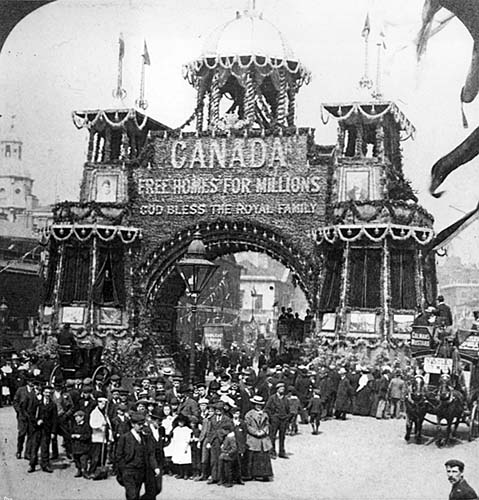RE/MAX RIVER CITY
#100, 10328 81st Ave, Edmonton, Alberta
P: 780-439-7000
F: 780-439-7248
Thursday, January 7, 2016 - Canada in the 1900's

Welcome to Canada - the Canada of 1900. You'll find that it's very different from the country you live in now.
For one thing, it's not really an independent country. In foreign policy and some aspects of domestic policy, Britain can still call the shots. Canada's high Court isn't the Supreme Court of Canada - it's the British Judicial Committee of the Privy Council. The Constitution is sitting in London, England, not Ottawa, and it can't be amended without British consent.
Check out a 1900 map. Instead of 10 provinces, it has only 7, plus one territory and 8 Districts. Alberta, Saskatchewan and Newfoundland haven't joined the party yet. Ontario, Québec and Manitoba occupy a lot less land mass than they do in Y2K.
Canada is primarily a British or French, Christian, agricultural, male-governed country. Most people - almost 63% - live on farms, not in cities. The vast majority - almost 90% - have their roots in the British Isles (58%) or France (31%). Although there are Francophones in all regions of the country; many solidly established in the Maritime provinces and Ontario, only in the province of Quebec are they a majority.
Under the Dominion Lands Policy, land is cheap and plentiful for immigrants and pioneers willing to farm it. 160 acres cost only $10. Homesteaders are given 3 years to build a house - often out of sod or logs - and cultivate a set amount of the land .
Domestic service is the most common paid employment for women in 1900. In the 1890's, up to 40% of female employment was in this area. Many secretaries and office support staff are male. By 1921, the percentage of employed women in domestic service will be down to 17%, as women move in non-traditional jobs. A good ladies street skirt will set you back $6.00, a pound of Mocha-Java coffee costs 35 cents, and a pair of skate blades cost between 25 cents and $5, depending on the quality.
Montreal is the largest city in the country, with 267,730 inhabitants in 1901.
Canada is a class-based society, with clear racial and economic distinctions separating the rich and the working class. The average yearly wage for production workers is $375. For office and supervisory employees, the annual income is $846. On average, women earn about half of what men do . In most cases, services are available based on money, not need. A new emphasis on capitalism is creating a small but growing middle class of office workers and managers.
The Districts that will become Alberta and Saskatchewan are still under-populated, and the Dominion government is making a great effort to settle them. There is great concern over the influx of non-British immigrants: Ukrainians, Hutterites, Scandinavians, people of colour and Germans. Growing wheat is problematic, because farmers are having a tough time cultivating wheat in the short growing season of the Prairies. In 1900, for much of the population, life is hard. In the rural areas there is no running water or indoor plumbing, no electricity, little access to medical facilities, and low incomes. Edmonton's first school was built in 1881, only 19 years ago.
There are about 600 divorced persons out of 1,833,000 married Canadians.
We're also at war. Sort of. The Boer War has been sputtering along since October 11, 1899. It's being fought by Britain against the Boers of South Africa, and due to popular demand in some quarters, Canadian troops are in the thick of it. But it's causing a devil of a problem for Prime Minister Wilfrid Laurier.
A system of common public schools financed with public funds has been operating in Quebec for close to 60 years. The Montréal Catholic School Board has existed since 1845 and Laval University, the first French-speaking university in North America, for close to 50 years.
There are less than 200 automobiles registered in all of Canada - and every one of them is in Ontario. The first automobile in Canada, however, was on the road in Rustico, Prince Edward Island, 34 years earlier; at the wheel was the local priest, Father Georges-Antoine Belcourt, originally from Quebec. The first one had been built in Canada 3 years earlier.
Statistics
Prime Minister: Wilfrid Laurier (Liberal)
Population (Total) : 5,301,000
By Province:
Ontario 2,182,000
Québec 1,648,000
Nova Scotia 459,000
New Brunswick 331,120
Manitoba 255,000
British Columbia 178,000
Prince Edward Island 103,000
Territories and Districts 400,000
Males 2,752,000
Females 2,620,000
Young people between the ages of 10 and 19 - 1,140,000 (21%)
People per square mile - 1.55
The average number of people per household in 1900 - 5. In 1976 - 3.1.
By Origin:
European 5,105,000 (96.3%)
Aboriginal 127,000 (2.0%)
Asian 23,000 (.004%)
African 17,000 (.003%)
1 British 2,075,700
2 French 1,649,000
3 Irish 988,000
4 German 310,000
5 Aboriginal 127,000
6 Misc Europeans 47,000
7 Dutch 33,000
8 Scandinavian 31,000
9 Asian* 23,000
10 Russian 19,000
11 Africa 17,000
* includes Chinese, Japanese and Indians
Borrowed From: http://www.chrc-ccdp.ca/en/getBriefed/1900/population.asp
Archives
Categories
